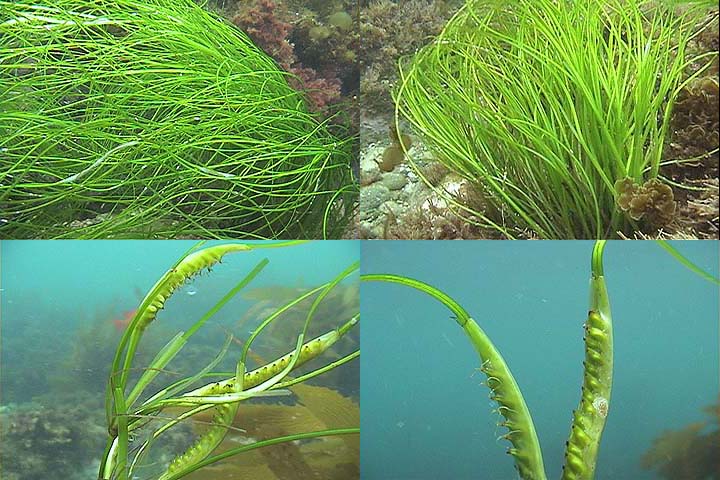

When most Californians think of plant life in the ocean, algae including seaweeds and the giant kelp forests come to mind. You would hardly expect to be able to pick a beautiful bouquet of flowers in the ocean. Yet there are flowering plants in the sea, although perhaps only a mermaid would find them beautiful. We have three different species in southern California waters: one eelgrass and two surfgrasses.
Flowering plants produce flowers (duh) which are reproductive structures with male and female parts. We are all familiar with the male products, especially if we have allergies like hay fever. Fortunately I don't appear to suffer from surfgrass or eelgrass allergies. Flowering plants also have vascular systems, conducting tubes that carry water and nutrients to the leaves and food produced by photosynthesis from the leaves to the rest of the plant. Algae are non-vascular since they can absorb nutrients throughout their bodies and produce food throughout much of their structure. Vascular plants have true roots that attach them to the substrate versus the holdfasts found on algae.
Eelgrass is normally found on soft substrates in the quiet waters of mudflats, bays and estuaries from the Oregon border to San Diego along our coast. It's ecological importance is in providing sheltered nursery grounds for many young invertebrates and fishes, or food for waterfowl, sea turtles and other species either as living plants or as organic debris (detritus) when it dies. Eelgrass seeds were even harvested by the Seri Indians in the Gulf of California and used like wheat for food. In addition to its economic importance in nurturing the young of species humans use for food, it also is of great value in preventing coastal erosion. When eelgrasses died off along the Atlantic coast in the early 1930's, apparently due to elevated water temperatures, the consequences included serious erosion.
The surfgrasses are more common and are found from the lower intertidal to depths of 20 feet attached to rocks along our shores. You can see them near the shore of Descanso Bay on Catalina. They likewise serve as food and as nursery grounds for many species. Young lobster often live within their rootstocks, making surfgrass habitat important for this commercial fishery... and those of us who enjoy their taste! Surfgrasses are not very tolerant of pollution. During the Santa Barbara oil spill of the late 1960's, tons of surfgrass blades (leaves) were destroyed by the oil. Fortunately the plants grew back from the surviving rootstocks. So if you like lobster, it's a good idea to drive an economy car like this marine biologist instead of a gas-guzzling SUV.
Prior to World War II and the rapid development of southern California following the War, several locations along our coast served as significant eelgrass and surfgrass habitat. These included the bays in the Los Angeles, Newport and San Diego areas. Human aesthetics often judged these areas less attractive. When they were drained and dredged for development, and pollution increased with growing human population along the shore, we lost important nursery areas for young marine life and food for waterfowl and sea turtles. Although limited restoration of these habitats has been attempted in some small areas, the ecological and economic consequences were significant and largely irreversible. Hopefully as long as I dive Catalina's waters I'll be able to pick a small bouquet of surfgrass flowers for the next mermaid that swims my way... as long as I'm not in the Dive Park or another marine protected area!
© 2003 Dr. Bill Bushing. Watch the "Dive Dry with Dr. Bill" underwater videos on Catalina Cable TV channel 49, 10:00 AM and 5:00 PM weekdays.

Image caption: Surfgrass and its flowers from Catalina's
Descanso Bay;
This document maintained by
Dr. Bill Bushing.
Material
© 2003 Star Thrower Educational Multimedia